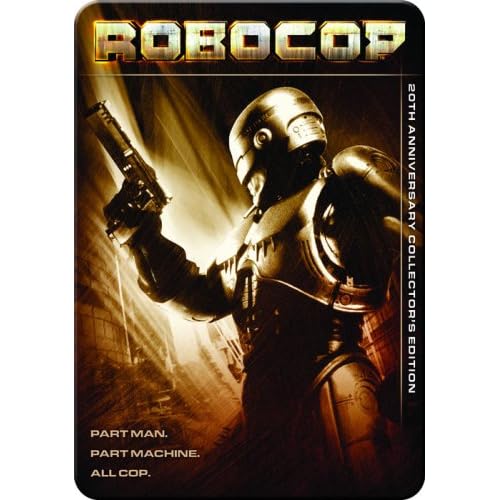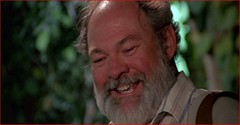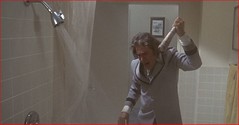
It was 20 years ago this summer that RoboCop was released, and the occasion is celebrated by finally delivering a proper DVD of it to consumers (more on that later). I first saw RoboCop the following summer, when my mom amazingly rented it for me and my friends to watch during my seventh birthday party. It was quite a coup, since we had all spent most of the year imagining what the movie could have been like -- and wondering how many years it would be before our parents would let us see it. I think the title fooled my mom -- it sounds innocent enough -- and I'll never forget the look on my friend Ben Maddox's face when I told him what movie we would be watching that evening (he gripped my shoulders and asked me to repeat, like he had just been told his parents had been eaten by wolves). Somehow we made it through the whole movie without my parents really catching on to what we were watching. Our minds were appropriately blown, and Paul Verhoeven's trademark shock value was a frequent topic of conversation that summer.
Many might shake their fist at DVD Savant when he says in his review that RoboCop is "both the best and the most important Science Fiction film of the 1980s." It doesn't appeal to everyone, but the movie is supremely important in the realm of Sci-Fi -- using the genre as a means to explore issues in our culture to a depth that a more traditional movie could not achieve. It's also important in how RoboCop represents the decade, using landmark "analog" effects to create a world not post-apocalyptic, but one that has clearly reached its peak and is slowly crumbling.
The movie opens with a futuristic Detroit where criminals no longer fear the police, and local badge is nearing strike after a recent massacre of their own. Compounding their fears is the decision of the city to turn over police operations to a private company, OCP -- with deep pockets and radical ideas of how to eliminate crime. The OCP way is not prevention, but annihilation with the frightening E.D. 209 concept -- a monstrous, armored robot that can mow down rows of criminals without thinking twice. But E.D. 209 famously malfunctions in the boardroom, emptying a few drums of bullets into a lacky suit, shifting the company's focus to another project, the RoboCop. Needing only a "volunteer," OCP finds one in Officer Alex Murphy, who in his first day after transferring to the dangerous downtown precinct is viciously executed by a gang of criminals.
We learn almost nothing about Murphy prior to his death, only that he has a family. In one of the movie's greatest sequences, we see the mechanical transformation of Murphy through his eyes, gradually gaining consciousness as his new identity is forged. This climaxes with an epic reveal, as the ordinary police officers in the precinct hear the thunderous footsteps of their new partner, then come face to face with the eye-less machine. Beyond saying that Murphy's memory was erased as part of the RoboCop program, we're given scant details as to how human he still is -- whether his brain is still somewhat intact, or whether his face was simply transplanted onto steel. However many human elements remain, Robo slowly starts to realize there is more to him than circuits, starting with memories of a home and a family who have since moved on after his death.
RoboCop's creators hail the project as something that will "eliminate crime" in Detroit within a decade, but Verhoeven explicitly shows that the only upgrade Robo offers over regular cops is his efficiency at killing. OCP believes that with enough RoboCops or E.D. 209's, the populace will be too afraid to commit crimes, a strategy that will produce more contracts with other cities. But Verhoeven also shows the business side of crime, with crooks bemoaning their notch on the ladder ("we steal this money but we never get to spend any of it!"), and drug kingpins running their rackets like blue collar business owners.
RoboCop would not have worked without the success of its titular character, and watching the new documentaries on the DVD, it's clear a lot of credit has to go to actor Peter Weller. Working for eight months with a mime expert from Juliard, Weller developed the mechanical body movements that convinced audiences they were seeing a well-polished machine. It's Weller's movements that help keep RoboCop a serious film, with his character never veering into Tin Man territory (the sequels had that area covered). Other aspects of the production design keep it another plane of Sci-Fi as well, starting with the still-amazing look of E.D. 209. Bearing no human aspects, the machine is still full of life and terror thanks to some of the best-applied stop-motion animation ever seen and a look of menace that separated it from other giant screen robots (interviews with the designers confirmed my suspicions that its "face" was inspired by a killer whale).
While other effects-heavy films of decades ago look dated, the concept of Future Detroit still succeeds. It is a future with modest technological gains, but a multitude of new problems. The scant remaining aspects of the past are soon to be paved over for a literally new city where the failings of municipal government will be replaced by privatization. Today, Murphy's loss of identity within his cyberclothes is an easy allusion to the bevy of techno-accessories that regularly weigh us down.
The DVD: After so many incomplete editions, it was refreshing to know a definitive RoboCop DVD was in the pipeline, and here it is. The most elusive extra has always been the uncut version of the film, which was contained in the early (and long out of print) Criterion edition. A later release by MGM contained a handful of documentaries, but you had to spring for the Trilogy box set to see the full cut (with the potential for that awkward explanation to your house guest of why you own RoboCop 3). Generously, both cuts are included in this edition, with each getting a cleaned up transfer and a DTS sound mix. So how is the unrated cut? After waiting years to see it, I have to admit that there's really not much difference. The main thing you'll notice is much more blood and bullets with the E.D. 209 boardroom scene, but other than that nothing really jumped out at me.
One of many new MGM releases to be housed in attractive "steelbook" packaging, RoboCop: 20th Anniversary Collector's Edition puts each version of the movie on its own disc. The first disc also contains the holdover extras from the last release (including Verhoeven's commentary), while the second disc has all new extra material. The new documentaries are quite good, with "Villains of Detroit" looking at the baddies with actors Ronny Cox, Kurtwood Smith and Ray Wise. Smith points out how his character (Clarence Boddicker) was crafted to be atypical, wearing glasses and a thin frame -- with his smarts being his most sinister weapon. "Special Effects: Then and Now" is the highpoint of the disc, with the film's creative talents providing informative insights into their processes and just how it was done. Much of this is spent on the creation of E.D. 209, including the exhaustive process of making the full-scale replica. A nice touch on this documentary is talking with the artists about today's special effects industry, particularly since their talents (matte painting, stop-motion animation) are pretty much extinct. The last documentary is "RoboCop: Creating a Legend," a nice look at everything RoboCop, such as his suit, the actor in it and even the gun (amazingly, they used an actual Beretta model which really did shoot three-round bursts).
Sunday, September 09, 2007
The Mind and the Metallurgy
Filed Under DVD
Subscribe to:
Post Comments (Atom)












3 comments:
I saw the uncut edition during winter break of our freshman year of college. In addition to the ED209 vs. the boardroom scene being more bloody, I seem to remember that the gang executing Murphy is way more graphic.
You saw this when you were 7? Good God. I love your story about your friend grabbing your shoulders in excitement. I miss that kind of excitement for a movie and not feeling geeky about it.
I have the Uncut Criterion version and love it. I think the massacre of Weller is a bit more graphic as is the toxic waste scene at the end.
I too saw this when I was rather young and my friend and I used to always repeat that line to eachother.
To me this still holds up as one of the best Sci-Fi movies to date.
I love that the E.D 209 kills the guy in the boardroom and no one is upset that a man has just died. They are upset that their investment just tanked.
This movie has lots of great lines, but one of my favorites is: "Sal, we're going to shove so much cocaine up your fat WOP ass, you're going to shit snow for a week."
The Murphy execution did feel more brutal, I think he screams in agony a bit longer before Clarence puts him out of his misery. The other great thing about the board room scene is the guy saying "Can someone call a paramedic!?!"
I love the cover of that Criterion disc, still one of my favorites. I've heard a lot about the commentary on that one (which is different than the new release), but the image and sound have been upgraded for the new one.
Post a Comment